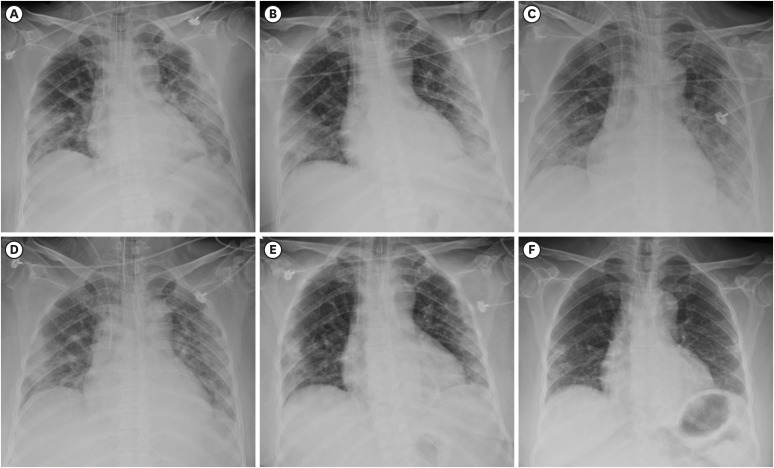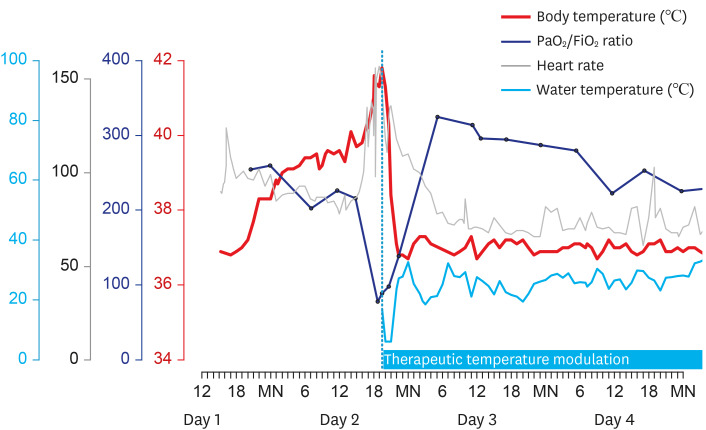J Korean Med Sci.
2020 Jun;35(22):e210. 10.3346/jkms.2020.35.e210.
Therapeutic Temperature Modulation for a Critically Ill Patient with COVID-19
- Affiliations
-
- 1Division of Neurocritical Care, Department of Neurosurgery and Neurology, Seoul National University Bundang Hospital, Seongnam, Korea
- 2Division of Pulmonary and Critical Care Medicine, Department of Internal Medicine, Seoul National University Bundang Hospital, Seongnam, Korea
- 3Division of Infectious Diseases, Department of Internal Medicine, Seoul National University Bundang Hospital, Seongnam, Korea
- 4Division of Cardiology, Department of Internal Medicine, Seoul National University Bundang Hospital, Seongnam, Korea
- KMID: 2502611
- DOI: http://doi.org/10.3346/jkms.2020.35.e210
Abstract
- We report a rapidly deteriorating coronavirus disease 2019 (COVID-19) patient, a-58-year-old woman, with severe acute respiratory distress syndrome and shock with hyperpyrexia up to 41.8°C, probably due to the cytokine storm syndrome. Considering extracorporeal membrane oxygenation (ECMO) as the last resort, we applied therapeutic temperature modulation for management of hyperpyrexia. The patient demonstrated rapid improvement in oxygenation and shock after achieving normothermia, and fully recovered from COVID-19 three weeks later. Therapeutic temperature modulation may have successfully offloaded the failing cardiorespiratory system from metabolic cost and hyperinflammation induced by hyperpyrexia. The therapeutic temperature modulation can safely be applied in a specific group of patients with cytokine storm syndrome and hyperpyrexia, which may reduce the number of patients requiring ECMO in the global medical resource shortage.
Figure
Reference
-
1. Mehta P, McAuley DF, Brown M, Sanchez E, Tattersall RS, Manson JJ, et al. COVID-19: consider cytokine storm syndromes and immunosuppression. Lancet. 2020; 395(10229):1033–1034. PMID: 32192578.
Article2. Chen N, Zhou M, Dong X, Qu J, Gong F, Han Y, et al. Epidemiological and clinical characteristics of 99 cases of 2019 novel coronavirus pneumonia in Wuhan, China: a descriptive study. Lancet. 2020; 395(10223):507–513. PMID: 32007143.
Article3. Siddiqi HK, Mehra MR. COVID-19 illness in native and immunosuppressed states: a clinical-therapeutic staging proposal. J Heart Lung Transplant. 2020; 39(5):405–407. PMID: 32362390.
Article4. Cho YJ, Moon JY, Shin ES, Kim JH, Jung H, Park SY, et al. Clinical practice guideline of acute respiratory distress syndrome. Tuberc Respir Dis (Seoul). 2016; 79(4):214–233. PMID: 27790273.5. Doyle JF, Schortgen F. Should we treat pyrexia? And how do we do it? Crit Care. 2016; 20(1):303. PMID: 27716372.
Article
- Full Text Links
- Actions
-
Cited
- CITED
-
- Close
- Share
- Similar articles
-
- How We Have Treated Severe to Critically Ill Patients With Coronavirus Disease 2019 in Korea
- Experience of Treating Critically Ill COVID-19 Patients in Daegu, South Korea
- Characteristics of Critically Ill COVID-19 Patients in Busan, Republic of Korea
- Hyper- and hypocoagulability in COVID-19 as assessed by thromboelastometry -two case reports-
- Risk factors associated with development of coinfection in critically Ill patients with COVID-19



